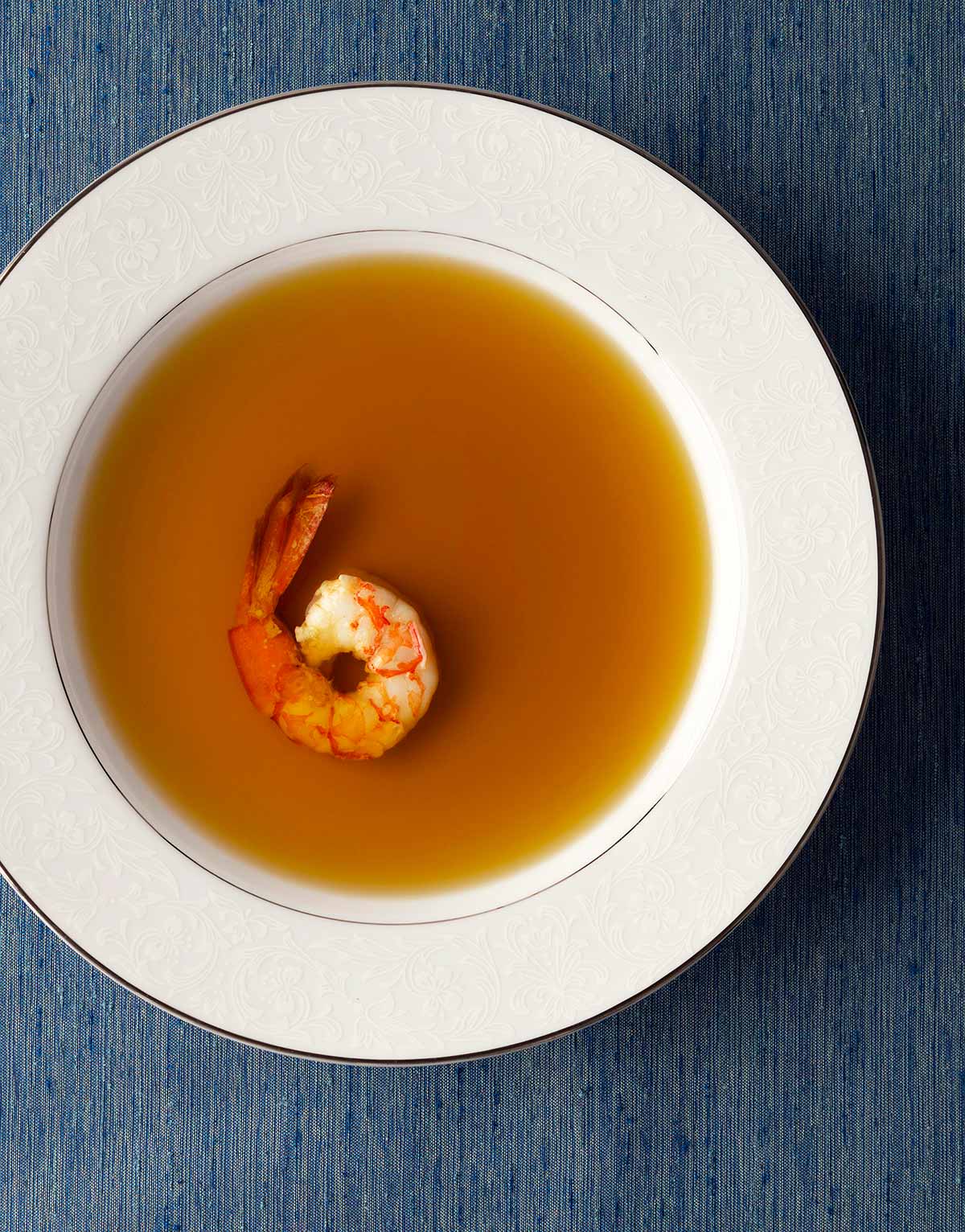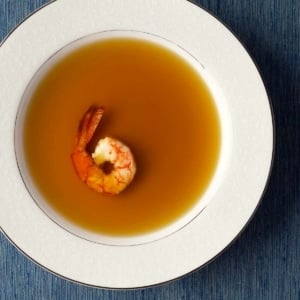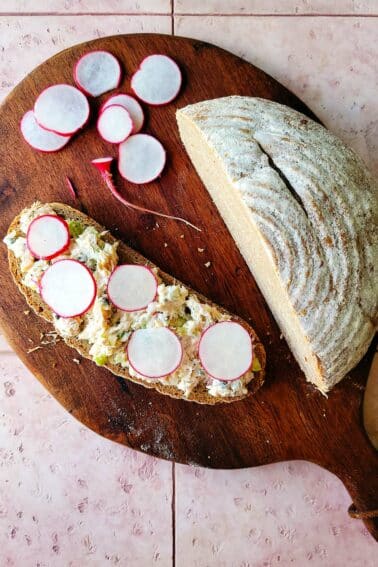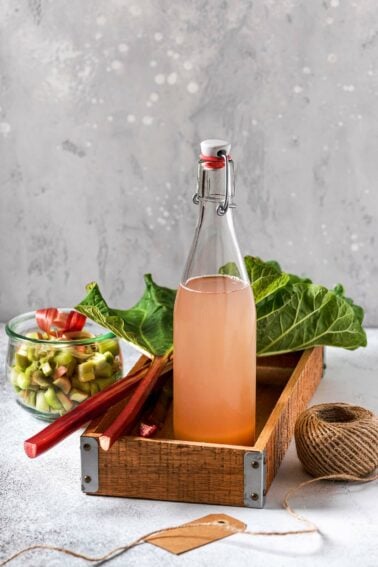As an Amazon Associate I earn from qualifying purchases.
If you have shrimp with shells, you can make shrimp stock.
In a perfect world, you would live near the sea, or to a fishmonger good enough to stock shrimp with their heads on — and you’d use those heads for your shrimp stock. But alas, most of us do not.

No worries, you can make a lovely shrimp stock at home using just shells. That said, you want more shells than you typically will get when you buy a pound or so of shrimp.
The thing to do is to shell your shrimp, then put the shells in a plastic bag and freeze them until you have shells from at least 2 pounds of shrimp. Note that I am not saying two pounds of shrimp shells, although if you had that many you could make a big batch of shrimp stock.
This general principle works with any shellfish. I save crab, lobster and crawfish shells for seafood stock. Fish stock is a bit different. I typically make fish stock with fresh skeletons and bones, and I rarely freeze it.
Which brings up a major difference between stocks made from birds and land animals versus stocks made with watery things. The former stocks store very well either frozen or pressure canned. The latter do not.

This is not to say you cannot preserve your stock. People do, and if you want to, I strongly urge you to freeze it, not pressure can it. The reason is because thawed stock will taste better than pressure canned stock from fish or seafood. The high heat involved in pressure canning does not help these stocks.
I almost always make shrimp stock and use it within a week, creating a sort of shrimp fest where I eat the shrimp in, say, Lowcountry shrimp perloo, making the stock for that dish, then using the leftover stock for a shrimp risotto or somesuch later in the week. Mexican caldo de camaron is another great use for shrimp stock.
How do you make shrimp stock? It’s way easier than with mammal or bird-based stocks. In fact, it takes less than 2 hours start to finish. You don’t really want to simmer it very long, or it will get overly fishy. And you also only make smaller batches, since it isn’t as good frozen as, say, duck stock.
My recipe has two ingredients that are easily found in supermarkets, but are optional: saffron and fennel. Fennel, also called anise, is a white bulb that tastes faintly of licorice, and saffron adds aroma and a pretty yellow hue to the stock. Saffron + seafood is a classic match. And besides, you only need a pinch.
Shrimp Stock
Ingredients
- 2 tablespoons olive oil
- 1 yellow or white onion, chopped
- 1 celery stalk, chopped
- 1 large carrot, chopped
- The top from 1 fennel bulb, chopped
- 4 cups shrimp shells, from about 2 pounds of shrimp
- 2 bay leaves
- 1 teaspoon dried thyme
- 1 teaspoon cracked black peppercorns (not ground)
- 1 cup white wine
- 1 pinch of saffron
- Salt
Instructions
- Heat the olive oil in a medium-sized pot over medium-high heat. Saute the onions, celery, carrot, fennel and shrimp shells until the vegetables are translucent and the shells turn orange, about 6 to 8 minutes.
- Add the bay leaves, thyme and peppercorns, then the white wine. Bring to a boil, then cover everything with water to a depth of about 1 inch. Crumble the saffron into the broth. Let this simmer gently for 45 minutes to 1 hour.
- Set a paper towel inside a strainer and put the strainer over a large bowl. Ladle the stock from the pot through the strainer to remove all debris. Add salt to the strained stock to your liking.
Notes
Nutrition
Nutrition information is automatically calculated, so should only be used as an approximation.





Hi Hank, This may sound dumb, but do you simmer covered, partially covered, uncovered? Does it make a difference?
Amelie: I simmer partially covered.
High five on this one! This is exactly the way I make my shrimp stock, minus the saffron. I use the incredibly fragrant fronds from the wild fennel growing in my yard. If you happen to have any put it to good use. It’s lovely in all kinds of brines, too.
Hey Hank,
Fixin to use the shrimp broth as a base for your East African fish stew. Would it church her up to sub coconut water like you do with the fish broth, or should I stick with hose flavor?
Bubba: I like using coconut water for this, so go for it!
Hello!
Can you clarify the serving size for the nutrition info provided? I’m trying to figure out if shrimp broth is high in calcium. Thank you!
Branda: Not really. You should never trust nutrition calculators on the web — they are all just guesses and estimates. I include them because Google requires me to. That said, just off the top of my head I would not think that shrimp stock would be high in calcium.
Hi Hank great info for raw shrimp shells.. my question will it work on shells from cooked shrimp or as we call them in Australia prawns ? I buy and eat cooked prawns from trawlers and farms all year round (I live in sunny Queensland and lucky to get them) just peeled around 3kilos of very fresh prawns and such a shame to waste… look forward to reply if you’re still around ??
Josie: Yes, it will work with cooked shells.
How long will this stock keep in the refrigerator?
Shawna: Definitely 5 days without any off odors, and it should be still safe to eat in 7 days. Beyond that, it still might be good, but will be a little smelly.
Sometimes I buy whole, head-on, shrimp to grill. When I don’t use it all I freeze the whole shrimp and then use them as the base of a seafood stock (along with other assorted shells that I’ve frozen). Works like a charm. It’s stronger than if you only used shells, but it’s amazingly flavorful. Works great when you add a cup or so to a large pot of cioppino, or half a cup to a fra diavolo or use when making seafood risotto.
Hank- Thanks. That was my thought. Unfortunately I’ve got a big bag of frozen uncooked but peeled shrimp. I’ll have to hold off on the shrimp risotto recipe that called for this stock… for now then. I’ll make something else this this time around!
I’ve made this stock a couple times in the past but I’m currently out of “fresh shrimp shells”. I do have a jar of dried powdered shrimp shells on hand. Any thoughts on using this as a substitute?
Richard: I wouldn’t. They can be very strong smelling. I freeze shells and use them as needed.